Earlier this year, the Great Red Spot stood out prominently against Jupiter's bright zones and dark belts. Damian Peach
Scientists think they’ve figured out what causes the mysterious ruddy coloring in the giant planet’s enormous oval storm.
When it comes to well-known planetary features, Jupiter’s iconic Great Red Spot is near the top of everyone’s list. It’s truly enormous — much bigger than Earth — though its girth has shrunk over the past decade.
The Great Red Spot is as mysterious as it is majestic. Unlike hurricanes and cyclones on Earth, which come and go in a matter of days, this iconic oval has endured for centuries. Giovanni Battista Riccioli and Gian Domenico Cassini noted it during the mid-1600s, though it could well have existed well before then.
Astronomers have long pondered what causes the GRS to be so red — at least most of the time (the intensity of its hue changes, varying from a dark salmon to nearly white).
One important clue comes from the spot’s overall structure and 5-day-long rotation. Unlike terrestrial hurricanes, which are low-pressure storms, the GRS is a high-pressure (anticyclonic) system that’s much taller than the clouds surrounding it. The spot’s cloudy interior is also relatively opaque, meaning whatever particles are coloring it must float near the top of this giant, buoyant bubble.
For decades atmospheric chemists believed that the spot was tinted with phosphine (PH3), an unusual compound found in the Jovian atmosphere. But more recently attention has focused on sulfur and its colorful allotropes. One of Jupiter’s three dense cloud layers consists of ammonium hydrosulfide (NH4SH), which, the thinking goes, could be dredged up by atmospheric convection and broken down by sunlight to form elemental sulfur.
That’s what Kevin Baines, Robert Carlson, and Thomas Momary (all at the Jet Propulsion Laboratory) had in mind when they began laboratory experiments to try to replicate the coloring process. Carlson irradiated ammonium hydrosulfide with ultraviolet light, to mimic sunlight. But the resulting compounds were bright green, not red!
So the researchers instead tried irradiating a mixture of ammonia (NH3) and acetylene (C2H2), both of which exist in Jupiter’s upper atmosphere. The result was a red concoction of cyanide-like molecules with the general formula HxCyNz where x, y, and z vary. Better still, the reddish particles have a spectrum that closely matches what NASA’s Cassini spacecraft recorded inside the Great Red Spot when it swept by Jupiter in late 2000 while en route to Saturn.

